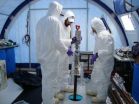(Press-News.org) CAMBRIDGE, MA -- A new imaging technique developed at MIT offers the first glimpse of the degeneration of two brain structures affected by Parkinson's disease.
The technique, which combines several types of magnetic resonance imaging (MRI), could allow doctors to better monitor patients' progression and track the effectiveness of potential new treatments, says Suzanne Corkin, MIT professor emerita of neuroscience and leader of the research team. The first author of the paper is David Ziegler, who received his PhD in brain and cognitive sciences from MIT in 2011.
The study, appearing in the Nov. 26 online edition of the Archives of Neurology, is also the first to provide clinical evidence for the theory that Parkinson's neurodegeneration begins deep in the brain and advances upward.
"This progression has never been shown in living people, and that's what was special about this study. With our new imaging methods, we can see these structures more clearly than anyone had seen them before," Corkin says.
Parkinson's disease currently affects 1 to 2 percent of people over 65, totaling five million people worldwide. The disease gradually destroys the brain cells that control movement, leaving most patients wheelchair-bound and completely dependent on caregivers. "A major obstacle to research on the causes and progression of this disease has been a lack of effective brain imaging methods for the areas affected by the disease," Ziegler says.
In 2004, Heiko Braak, an anatomist at Johann Wolfgang Goethe University in Frankfurt, Germany, classified Parkinson's disease into six stages, based on the appearances of the affected brain structures. He proposed that during the earliest stages, a structure deep inside the brain, known as the substantia nigra, begins to degenerate. This structure is critical for movement and also plays important roles in reward and addiction.
Later, Braak proposed, degeneration spreads outward to a brain region known as the basal forebrain. This area, located behind the eyes, includes several structures that produce acetylcholine, a neurotransmitter important for learning and memory.
Neuropathologists (scientists who study the brains of deceased patients) had found evidence for this sequence of events, but it had never been observed in living patients because the substantia nigra, deep within the brain, is so difficult to image with conventional MRI.
To overcome that, the MIT team used four types of MRI scans, each of which uses slightly different magnetic fields, generating different images. By combining these scans, the researchers created composite images of each patient's brain that clearly show the substantia nigra and basal forebrain. "Our new MRI methods provide an unparalleled view of these two structures, allowing us to calculate the precise volumes of each structure," Ziegler says.
After scanning normal brains, the researchers studied 29 early-stage Parkinson's patients. They found significant loss of volume in the substantia nigra early on, followed by loss of basal forebrain volume later in the disease, as predicted by Braak.
In future studies, this MRI technique could be used to follow patients over time and measure whether degeneration of the two areas is correlated or if they deteriorate independently of one another, Corkin says.
This approach could also give doctors a new way to monitor how their patients are responding to treatment, she says. (Most patients are treated with dopamine, which helps to overcome the loss of dopamine-producing neurons in the substantia nigra.) Researchers could also use the new imaging tools to determine the effects of potential new treatments.
INFORMATION:
Written by Anne Trafton, MIT News Office
END
For researchers who study Earth's past environment, disentangling the effects of climate change from those related to human activities is a major challenge, but now University of Massachusetts Amherst geoscientists have used a biomarker from human feces in a completely new way to establish the first human presence, the arrival of grazing animals and human population dynamics in a landscape.
Doctoral student Robert D'Anjou and his advisor Raymond Bradley, director of the Climate System Research Center at UMass Amherst, with UMass colleagues Nick Balascio and David Finkelstein, ...
NEW YORK (November 26, 2012)—Scientists have developed a system to predict the timing and severity of seasonal influenza outbreaks that could one day help health officials and the general public better prepare for them. The system adapts techniques used in modern weather prediction to turn real-time, Web-based estimates of influenza infection into local forecasts of seasonal flu.
Results appear online in the Proceedings of the National Academy of Sciences.
Year to year, and region to region, there is huge variability in the peak of flu season, which, in temperate areas ...
Several drugs companies have ineffectively tried to produce antibodies that bind to the IGF-1 receptor on the cell surface, which has a critical part to play in the development of cancer. Scientists at Karolinska Institutet in Sweden have now ascertained how these antibodies work, and can explain why only some cancer patients are helped by IGF-1 blockers during clinical tests. The researchers also present a means by which drugs of this kind could help more cancer patients.
Every cell contains thousands of tiny receptors that help it communicate with other cells. These ...
RENO – This week a pioneering study published in the Proceedings of the National Academy of Sciences (PNAS) and co-authored by Dr. Alison Murray and Dr. Christian Fritsen of Nevada's Desert Research Institute (DRI) reveals, for the first time, a viable community of bacteria that survives and ekes out a living in a dark, salty and subfreezing environment beneath nearly 20 meters of ice in one of Antarctica's most isolated lakes.
Lake Vida, the largest of several unique lakes found in the McMurdo Dry Valleys, contains no oxygen, is mostly frozen and possesses the highest ...
SALT LAKE CITY— Discovery of a new drug with high potential to treat Ewing sarcoma, an often deadly cancer of children and young adults, and the previously unknown mechanism behind it, come hand-in-hand in a new study by researchers from Huntsman Cancer Institute (HCI) at the University of Utah. The report appears in today's online issue of the journal Oncogene.
"Ewing sarcoma is almost always caused by a cancer-causing protein called EWS/FLI," said Stephen Lessnick, M.D., Ph.D., director of HCI's Center for Children's Cancer Research, professor in the Department of ...
Biologists at UC San Diego have demonstrated for the first time that marine algae can be just as capable as fresh water algae in producing biofuels.
The scientists genetically engineered marine algae to produce five different kinds of industrially important enzymes and say the same process they used could be employed to enhance the yield of petroleum-like compounds from these salt water algae. Their achievement is detailed in a paper published online in the current issue of the scientific journal Algal Research.
The ability to genetically transform marine algae into ...
This press release is available in Spanish.
Student engagement is not independent of the type of school attended.Nor is it independent of the organisational development of the school.The school's organisational style affects the work of its teaching staff, which, in turn, has repercussions on the performance and engagement of their students.As IkerRos, the UPV/EHU researcher, has been able to verify in his PhD thesis, these factors vary when comparing public schools, subsidised schools and co-operative schools, the latter being the ones that fare best.
"The study of ...
(NEW YORK, N.Y., November 26, 2012) – Autism Speaks Chief Science Officer Geraldine Dawson, Ph.D. describes how the dramatic progress in autism research has paralleled increased recognition of autism's prevalence and financial impact in the December issue of the Archives of General Psychiatry published on line today. "This issue of the journal features three articles on autism," she writes in her editorial. "A decade ago, the journal published about the same number of autism articles per year."
Dr. Dawson also notes that, while the funding for autism research has dramatically ...
An area of the brain called the orbitofrontal cortex is responsible for decisions made on the spur of the moment, but not those made based on prior experience or habit, according to a new basic science study from substance abuse researchers at the University of Maryland School of Medicine and the National Institute on Drug Abuse (NIDA). Scientists had previously believed that the area of the brain was responsible for both types of behavior and decision-making. The distinction is critical to understanding the neurobiology of decision-making, particularly with regard to substance ...
SAN DIEGO, Calif. (November 26, 2012) The Algae Biomass Organization, the trade association for the U.S. algae industry today hailed the findings of a University of California at San Diego study that concludes, for the first time, that marine (saltwater) algae can be just as capable as freshwater algae in producing biofuels. The research is documented in a peer-reviewed paper published online in the current issue of the scientific journal Algal Research.
"What this means is that you can use ocean water to grow the algae that will be used to produce biofuels. And once ...



